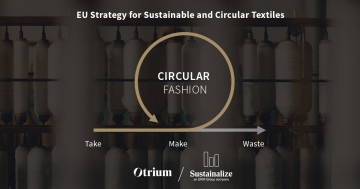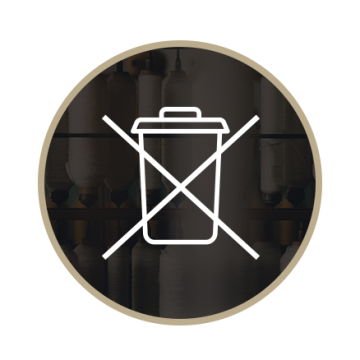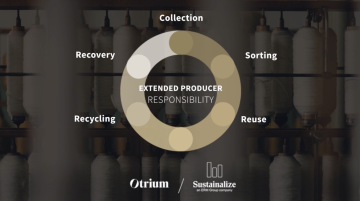Conscious
Unravelling sustainability laws in fashion - EU Strategy for sustainable and circular textiles

We want to help our brand partners, both present and future, keep on top of the newest and forthcoming laws and legislation around sustainability and achieve their Environmental, Social, and Governance (ESG) goals.
29 JUNE 2022
At Otrium, we’re committed to a future where all clothing is worn, by ridding the world of unsold inventory and changing the way clothing is created and sold. We want to help our current and future brand partners, stay on top of new and forthcoming laws and legislation around sustainability and achieve their Environmental, Social, and Governance (ESG) goals.
So, in collaboration with leading Corporate Sustainability Consultancy Sustainalize, we’re launching a series of blog posts aimed at simplifying these new laws and legislation. These posts will also contain guidance to help fashion brands comply with these policies. We expect they will prove to be useful.
Our first blog post unravelled the Extended Producer Responsibility (EPR), and can be read here. Within this piece we’re focusing on the EU Strategy for sustainable and circular textiles, what it contains, and how fashion brands can contribute to and prepare for this new strategy.
The purpose of this new strategy
The European Commission published the EU Strategy for sustainable and circular textiles to tackle problems in the textile industry. The proposal aims to decouple economic growth from the consumption of finite resources by making steps towards a circular European fashion landscape. If successful, the strategy would be beneficial both for businesses and the environment.
Greater longevity for clothing and sustainability-focused product design are key to reducing the fashion industry’s negative environmental impact. When implementing the strategy successfully, the European fashion landscape in 2030 will consist of:
- Recyclable textiles with longer lifespans Textile products must be composed of recyclable fibres as much as possible, be free from hazardous substances, and be produced in a manner that supports social and environmental responsibility goals.
- High-quality textiles worth repairing and reusing Consumers benefit longer from high-quality, affordable textiles, fast fashion is out of fashion, and economically profitable re-use and repair services are widely available.
- Producer responsibility throughout the entire life cycle In a competitive, resilient and innovative textiles sector, producers take responsibility for their products along the value chain, including when they become waste. (i.e., Extended Producer Responsibility policy, read more here).
- Less textile waste The circular textiles ecosystem is thriving, driven by sufficient capacities for innovative fibre-to-fibre recycling, while the incineration and landfilling of textiles are reduced to the minimum. (i.e., Eco-design policy)
To reach this vision several key actions should be taken:

The main regulations that support these key actions
The EU Strategy for sustainable and circular textiles is based on existing European initiatives, directives and regulations. The following three are central to the EU strategy for textiles.
- Eco-design for sustainable product regulation
This regulation will expand durability and recyclability for specific product groups (e.g. textiles,tyres , paints, etc.) by implementing requirements to improve products' circularity and energy performance.
In addition, the regulation will require information disclosures for products' environmental impacts and traceability of all substances of concern throughout the products' lifecycle.

- The voluntary EU Ecolabel scheme
The label enables consumers to make informed choices and identify environmentally friendly products. It aims to promote a circular economy and implement criteria for various products, including textiles. For example, textile products have to meet certain requirements on harmful substances, water use, air pollution, colour resistance to washing, light exposure, and perspiration.
- Waste Framework Directive
The Waste Framework Directive was developed in 2008 to improve waste management, and protect human health and the environment from hazardous substances. The directive is based on the waste hierarchy establishing an order for managing waste.
It introduces the polluter pays principle, meaning that the polluter should bear the costs of pollution prevention and control measures.

What does the Strategy mean?
All the signs show that soon there will be extensive binding legislation for textiles. Since the EU strategy will be applicable to all European companies, we recommend that fashion brands and producers quickly get up to speed on integrating the circularity principles into their business models.
But where to start? To make it a bit more concrete we will give insight into two existing initiatives in the UK and the US. This will give you an idea of what a legislation might look like, for whom this will be applicable and how you might have to disclose your sustainability practices in the future.
Textiles 2030 WRAP (UK)
Textiles 2030 is a voluntary initiative launched by the organization WRAP (Waste & Resources Action Programme). This initiative aims to reduce greenhouse gases and the water footprint of products. In addition, it creates and delivers a circular roadmap for textiles in the UK.
Currently, the agreement gathered 92 signatories representing 62% of the UK clothing market.
Retailers and brands will have to report on:
1. The total quantity of textile products placed on the market.
2. The fibre breakdown of the total quantity of new products sold.
3. The improvement actions taken, measured as a proportion of relevant products by weight.
4. And commit to build visibility of their supply chain.
The Fashion Act (New York)
The New York Fashion Sustainability and Social Accountability Act, will be the first US law that will hold all major brands accountable for their environmental and social impacts.
This applies to fashion companies doing business in New York and generating an annual global revenue of $100 million or more. Reaching luxury brands as well as fast-fashion brands.
Fashion companies will have to:
1. Map at least 50% of their supply chains and disclose environmental impacts (GHG, water, chemicals).
2. Report the total volumes of materials they produce.
3. Reduce their impacts, including by setting and meeting Science-Based Targets for their greenhouse gas emissions.
4. Disclose median wages for workers and what measures are in place to embed responsible business conduct into policies and management systems.
Ways Otrium can help
At Otrium, we’re constantly working towards making the fashion industry smarter and less wasteful. Our purpose is clear: all clothing should be worn. It’s why we use data to solve the excess inventory problems that fashion brands often face. And it’s why we polish archive garments we receive from brands, repairing, pressing and steaming them so they regain their value, and have the best chance at finding a new home.
It’s also why we carefully repair and refurbish all our own returns, keeping them out of landfill. Any items that we cannot refurbish into good-as-new quality are stored separately at our warehouse in a separate section. Currently we are working on setting up our own circular program pilot to find a way to repurpose these.
Partnering with Otrium to match end of season and archive collections with our community of fashion-lovers is an ideal way for brands to be more circular. From the design stage and managing supply and demand, to dealing with unsold products, our data-driven systems are successfully saving many thousands of items from ending up in landfill.
Can we help your brand? Get in touch with us.
About Sustainalize
We are Sustainalize, a new generation of sustainability specialists. Since 2010, we have grown from an unknown small-scale interrupter to a strong market leader in the field of sustainability advice. As an ERM Group company, Sustainalize is now part of the largest pure-play sustainability consultancy in the world.
A sustainable future requires companies to focus on creating long-term value. Value for people, the environment and society, combined with healthy financial results. But how do you manage that? By staying inventive. We are results driven, ahead of the curve when it comes to the latest innovations and regulations. And we’re more than happy to share them with you.
Stakeholders, laws and legislation, and rating agencies increasingly expect companies to be open in their sustainability policy and performance. We’re familiar with various methodologies and understand the challenges involved in complying with (forthcoming) laws and regulations. In addition, together with our valuable partnerships, we can help to quantify - and communicate about – your sustainability performance. We translate your needs into a concrete improvement plan and connect this with your business strategy.
Sources
More from Otrium
See all articles
At Otrium, we’re constantly working towards making the fashion industry smarter and less wasteful. We also want to help our brand partners, both present and future, keep on top of the newest and forthcoming laws and legislation around sustainability and achieve their Environmental, Social, and Governance (ESG) goals.
So, in collaboration with leading Corporate Sustainability Consultancy Sustainalize, we’re launching a series of blog posts aimed at simplifying these new laws and legislation. These posts will also contain guidance to help fashion brands comply with these policies. We hope they prove to be useful.
First up, is Extended Producer Responsibility (EPR). What is it, and why do fashion brands need to know about it?
EPR - an explanation Broadly speaking, EPR is a waste management concept aimed at reducing pollution and landfill use, while increasing recycling rates. In fashion industry-specific terms, it’s a policy whereby brands bear a significant degree of responsibility for the environmental impacts of everything they produce, taking the whole life-cycle of garments and accessories into account.
It’s not a new idea - it was first introduced over 30 years ago - but the importance of developing more circular systems for dealing with all textiles is becoming ever more apparent. EPR is intended to reimagine how every company and organisation sources and uses their materials, plus how they dispose of and reuse them.
What EPR would mean
The results of introducing an EPR policy could:undefinedundefinedundefinedCurrently, the EU’s only mandatory EPR is in France. But several European countries are investigating similar schemes for textiles including the Netherlands and Sweden. The European Commission is considering EPR as a general regulatory measure to promote sustainable textiles and better recycling for textile waste. The UK government has also committed to review and consult on an EPR scheme. Over in the US, various undefined and coalitions are lobbying policymakers to make EPR a reality there too. It’s not clear whether any of these will become mandatory, or even coordinated across countries. Either way, EPR and everything it potentially involves is an important consideration for everyone in the fashion industry.
EPR in France
France’s EPR policy was introduced in 2007 and passed into law to cover end-of-use clothing, linen, and shoes in January 2020. The policy is governed by Refashion (formerly Eco TLC), an accredited non-profit organisation, which represents 95% of the French textile industry and is responsible for the collection, recycling, and recovery of used textiles. The destruction of unsold textile products is forbidden under law.
France’s target for 2022 is to collect 50% of all the textiles put on the market, and from this collection, reach 95% of reuse or recycling of textiles, and a maximum of 2% waste. Policymakers have also implemented an extension of circularity on transparency of the production, as well as the bonuses and penalties paid by the manufacturers and information on potentially dangerous substances.
EPR in The NetherlandsThe Netherlands has a draft regulation that focuses on garments and home textiles.All producers in the Netherlands, as well as external producers who market within the country (including ecommerce), need to appoint a legal entity to carry out the EPR. By 2025, municipalities will have to collect textiles separately. The Dutch government has a target for 2025 that 50% of textile products should be recycled or reused. Producers are obligated to report their figures annually. By 2030, this target will increase to 75%. The estimated cost of waste management for producers is €0.09 to €0.28 per kilogram of textile.
EPR in SwedenSweden introduced an EPR for textiles from 1 January 2022. It will be phased in over several years with licensed textile collections starting on 1st January 2024. It’s hoped that from 2028 onwards, at least 90% of the textile waste collected by the new system will be reused or sent for material recovery. Sweden’s target by 2028 is to reduce the average amount of textile sent to landfill by 70%.
How to prepare for EPRWhile the whole industry waits to find out whether these potential EPR regulations will be set in stone, there are two different initiatives that brands can consider implementing to get ahead of the pack.
Subscribe to Our Newsletter
Get the newest discounts, brands, and drops.
Otrium
Customer service
Customer service
© 2016-2025 Otrium, except certain content provided by third parties
